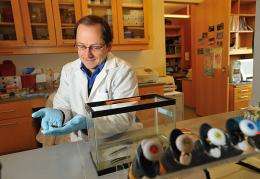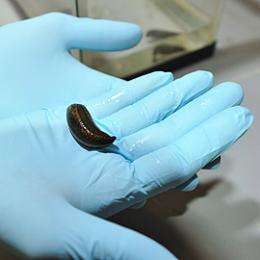How bacteria keep us healthy

(PhysOrg.com) -- Joerg Graf is studying medicinal leeches for clues about how changes in diet affect microorganisms in the digestive tract.
Many people think of bacteria as disease-causing agents that should be avoided for fear of getting sick. But molecular and cell biologist Joerg Graf points out that we can’t live without them.
He says there are actually more bacteria on and in humans than there are human cells. “If you took a person and removed all the human cells, you would still see the outline of a human body,” made up of bacterial cells, says Graf, an associate professor of molecular and cell biology in the College of Liberal Arts and Sciences.
Bacteria are on our skin, in our mouth and throat, in our intestines, nose, and virtually every nook and cranny of our bodies that is connected with the outside – and almost of all them are not bad for us.
Graf recently received a $1.6 million grant from the National Institutes of Health (NIH) to study bacteria that live in digestive tracts. The project is a collaboration with Pieter Visscher, a professor of marine sciences, and Hillary Morrison, a researcher at the Marine Biological Laboratory at Woods Hole. Their work will help scientists understand the vital role that bacteria play in our everyday health.
Many bacteria are essential to the normal functioning of physiological processes, including digestion and immune responses. The gut microbiome consists of all of the bacteria in the human gut and, for example, digests food that humans otherwise can’t, such as some plant material, as well as providing nutrients in forms that humans can use. Humans acquire these bacteria from their mothers as they pass through the birth canal and from the outside world through the course of their childhood. This is why, explains Graf, people in different parts of the world have different combinations of gut bacteria.

Graf and his colleagues are interested in how relationships between bacteria and their hosts have evolved, and how they change over an organism’s lifetime.
“We don’t understand what drives the changes in the gut microbiome,” he says, adding that it’s difficult to study the human gut because there are hundreds of different kinds of bacteria present.
Instead Graf and his colleagues work on a model system. “By having a simple system, we can understand it better using molecular tools.”
The model system they use is the medicinal leech, because the microbiome of its digestive tract is normally dominated by only two types of bacteria. These species help to degrade blood that the leech consumes, providing nutrients to the leech. With only two species to observe, Graf can study how this bacterial community changes with dietary shifts in the organism.
Like humans, leeches undergo a shift in their diet at a young age: while humans spend the first stages of their life drinking only milk, leeches also spend their first few days living only on protein provided by their mother. After feeding the leech its first actual blood meal, the scientists will observe the changes in the leeches’ gut bacteria by looking at the RNA they make, which will in turn produce different proteins that allow the bacteria to degrade the food and provide nutrients to the leech. To perform this work, they will use a gas chromatography-mass spectrometer that was purchased by Kenneth Noll, a professor of molecular and cell biology, using funds from the Provost’s Intermediate Research Equipment Competition.
“The function of these proteins is related to the bacterial species and can determine how diverse the functions are within one species,” and how the function changes as the microbial community changes, says Graf.
One of Graf’s hypotheses is that one of the bacteria uses a “molecular syringe” to inject a toxin that prevents the leech’s natural immune cells from attacking it. This molecular syringe is also a virulence factor that is required to cause disease in other animals, but not to the leech. In the leech, it simply signals that the bacteria are not enemies, and should be left alone.
Additionally, Graf is interested to find out whether these bacteria rely on each other for nutrients. Like the leech itself, one of the bacteria might rely on the other to converting food into a form that it can use, allowing it to grow faster.
All of these questions will help Graf and his colleagues determine how physiology changes when the gut microbiome changes, which could lead to insights about our dependence on the bacteria themselves. For example, people with inflammatory bowel disease have a different microbial community than those without, says Graf. Learning about the changes in bacterial gut communities and its contribution to the host animal could give clues about other diseases.
Graf is also involved with the Human Microbiome Project, which aims to characterize human microbial communities, including that of the gut, and to analyze their role in health and disease. Hundreds of scientists across the U.S. are working on this NIH-funded initiative.
Graf says that for him, being involved with these projects is like working to solve a puzzle.
“There are many different ways to do science,” he says. “We’re at a very exciting time in biology, with new techniques to sequence millions of DNA and RNA molecules. These techniques are proving very powerful.”
Provided by University of Connecticut
















